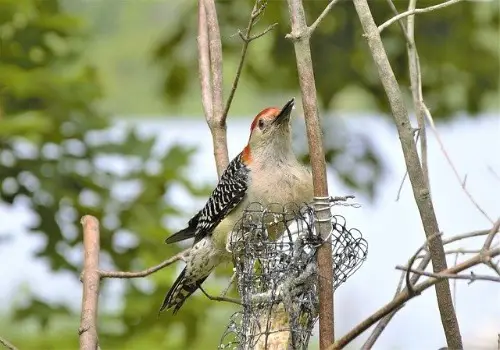Minnesota is at the frontier of woodlands and prairies from the eastern and western regions.
And because it is…
The habitats throughout the state provide homes to many birds, including the Minnesota woodpeckers, offering birders a spectacular view of the avian life.
Aside from its rich scenic beauty and bird-loving communities, Minnesota offers many birding opportunities in summer, spring, and fall.
Nevertheless, you can also expect the winter birds to grace observers with their presence in the colder months.
Before you grab your binoculars and enjoy wildlife, let's take a few moments to learn about the common woodpecker species in the area.
Different Species Of Woodpeckers In Minnesota
Woodpeckers never fail to captivate the attention of naturalists, bird enthusiasts, and experts worldwide. Many studies have been conducted on how these birds adapt to their unique lifestyles.
The misconception about woodpeckers is possibly from people who haven't seen one up close. Misrepresenting woodpeckers isn't surprising since this bird species are often inconspicuous or away from human eyes.
There is something mysterious and enigmatic about woodpeckers, which you can glimpse before they disappear behind a tree trunk or flee into the leafy forest.
Knowing a bird's rhythm is somewhat comforting. Thus, exploring the neighborhood or your backyard will leave you craving for more significant discoveries than you ever imagined.
Check out the profiles of the common woodpecker species you can expect to grace your backyard feeders and how you can identify them more easily:
1. Hairy Woodpecker
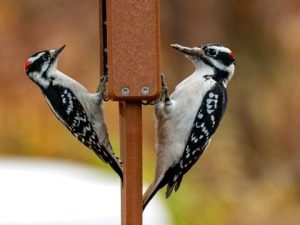
The hairy woodpecker is another familiar visitor in bird feeders; its name is due to the hair-like white feathers on the bird's black back. Hairy woodpeckers are sizable versions of the dinky-sized downy woodpeckers.
A hairy is a medium sized woodpecker, which is one way to tell these two similar species apart. You can also compare the size of their bills, since the hairies have bigger bills than their heads.
It is among the common woodpeckers with a long and sturdy bill, handy for foraging food, excavating tree cavities, and territorial drumming. Aside from the male's red patch at the back of the head, the female hairy woodpecker looks the same.
Males and females of this species have white bellies, black wings with white spots, and distinctive patterns on their faces.
Downies and hairies share an identical plumage but with a broad genetic distance separating them.
Additionally, the hairy woodpecker occurs in North and Central America, where it primarily resides as a sedentary, high-mountain bird.
Any birder will recognize its high-pitched, trilling sound while male hairy woodpeckers use their bills for drumming in a distinctive rhythm to establish territory.
The nesting behavior can also help you tell hairy woodpeckers apart from the downy woodpecker, as hairies are species that prefer to roost earlier. Both sexes work on their nest, taking turns to dig and carve a round entrance hole large enough for them to fit.
Despite being a natural pest controller, the hairies eat insects, moth pupae, and fruits and consume seeds at a backyard feeder.
Large trees, snags, or dead trees attract woodpeckers like the hairy. It also prefers to inhabit mature forests, such as coniferous, deciduous, and mixed woodlands. Nevertheless, it frequents urban gardens and parks within its range.
2. Red Bellied Woodpecker

The redbellied is among the woodpeckers in Minnesota that is less common in the northeast but more familiar and widespread in the southeast. Some observers used to mistake the red bellied woodpecker with the redheaded one due to the bright red stripe from its bill to the nape.
It's one of the medium sized woodpeckers sporting a stout bill, stiff tail, and strong feet, which the woodpecker utilizes when hitching tree trunks.
Not to mention that the feathers of a red bellied woodpecker are another rare feature, with its black and white stripes reminding you of a zebra. Red bellied woodpecker males have a prominent red patch from the head to the top of their bills and down to the nape.
The females have a red nape, but it is on their brownish-gray plumage at the top of their heads, and their belly patches are minimal. Likewise, these red bellied woodpeckers have a white rump that is more prominent in flight.
Its vocals are a loud ringing call, almost sounding like the forest trees are laughing; the red-bellied can also be boisterous in their undulating flight. Both sexes make an even-sounding drum, although females rarely do so.
Like the white- breasted nuthatches, tufted titmice, and black- capped chickadees, you will likely see these cavity-nesting woodpeckers bring food to their juveniles.
The red bellied woodpecker is undoubtedly an expert in excavating insects from trees, but it also eats fruits and nuts and likes sugar water in hummingbird feeders. Further, it will not hesitate to visit bird feeders with peanuts, suet, and sunflower seeds.
Such a woodpecker also takes apple halves and grape jellies from humans. When trying to spot red bellied woodpeckers, try looking in lowland and hardwood forests around Minnesota. It even favors a grove of poplar trees when building the nest.
3. Red Headed Woodpecker

If a rapping sound on your tin roof awakens you in the morning, a red headed woodpecker is likely visiting you.
It is one of the woodpecker species with sexually monochromatic males and females.
Red headed woodpeckers feature a bright red shade from their heads down to their necks, throats, and chests. It looks like a burning flame on top of the treetops.
These handsome creatures sport a thin black line that sets apart their red and white plumage; their lower backs are snowy white. The red headed woodpecker is one of the four bird species of the same kind that shows the behavior of storing food.
However, it is the only woodpecker that places wood or a tree bark over its stored food supplies as a protective covering. The red headed woodpecker has an extensive range, but sometimes its population fluctuates depending on the availability of food sources.
Several birds migrate to the south in winter, outside their breeding range. Male red-headed woodpeckers have a red hood that reaches their napes. The plumage color is how you can best identify between sexes when out in the field; at times, the redheads are also identical in size.
The young redheads have drabber brown and white plumages with streaks underneath, with a subtle rosy blush on their foreheads. Such species have vocals sounding like a quick, repeated squeal or a shrill, especially during the breeding season.
These woodpeckers have an impressively broad vocal repertoire, plus three types of calls similar to acorn or Lewis's woodpeckers. Males and females are responsible for the brief drumming rolls.
Further, its preference for dead trees of some dead parts from live trees is undeniable. But unlike other woodpeckers, the redhead is not an excellent excavator; hence it uses old tree cavities that other birds leave behind.
Redheads take the lead in foraging in their wintering range, so the downy woodpecker often feeds on the low canopy. Otherwise, the red-headed bird eats mostly insects, like bark beetles, but never the beetle larvae. Sometimes, the bird consumes nuts, fruit, corn, and sap.
You have more chances of spotting this woodpecker in woodlands with dying trees due to herbicides or winter storms.
4. Downy Woodpecker

The downy woodpecker is easily distinguishable with its black and white plumage, even with the comparable hairy woodpecker. Despite the striking similarities these two woodpeckers have, you will notice that the Downies are smaller and have a bright white neck extending to the belly.
Its tail and wing feathers are black with white spots, and the head is small and has a thin bill.
Also, the red patch on the back of the head of male downy woodpeckers is lacking in females. Likewise, the white spots on their dark wings depend on geographical variations, sometimes bold or occasionally subtle.
Similarly, these woodpeckers' black and white feathers on their outer tail occasionally have minimal markings. The size also varies, as the northern birds in cooler regions and high places are more sizable than the other woodpeckers of the same kind.
Downy woodpeckers are mostly residents in Northern American woodlands, the boreal and mountain forests south to the Atlantic and Gulf Coasts. Many bird enthusiasts notice the Downies' irregular distribution, particularly in the west, due to the scarcity of suitable habitats.
Its call can be in single, uneven series with an ascending pitch intensity or rapid succession like during a downy's courtship display. On the contrary, a breeding pair performs a duet while choosing a nesting tree.
A downy feeds mostly insects and visits the backyard for suet feeders, bird cakes, berries, and sunflower seeds. You can find this bird almost everywhere as long as there are trees that can supply them with their food.
However, due to the loss of dead trees, essential to a downy's nesting and feeding requirements, many have to compete with other birds for nesting sites.
5. American Three-Toed Woodpecker
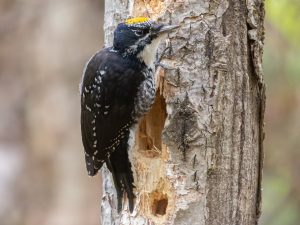
Most new birders are probably unfamiliar with the American three-toed woodpecker since it has a smaller population than other woodpecker species in the north. This woodpecker is a casual visitor in northern Minnesota forests during summer and winter.
American three-toed woodpeckers are non-migratory birds and are only nomadic when searching for habitats or prey.
Males have narrow white bars on their backs, and both sexes have noticeable white markings on their heads. These birds' nape and the lower sides of their throats feature a white line that is too thin you can hardly call it a stripe.
Additionally, three-toed woodpecker males have two white facial stripes contrasting their blackish heads, bright yellow crown, and long nasal tufts. The females comparatively have black crowns with white streaks.
Its squeaky call sounds similar to a downy woodpecker but less sharp; such a woodpecker has a shorter but diverse drumming repertoire. Like other woodpeckers, the American three-toed woodpecker prefers nesting in an excavated cavity on tree bark.
This woodpecker shows an affinity for snags in coniferous forests than living trees. And while the bird might nest on various tree species, it mainly favors conifers and dead or dying trees.
Much of its diet consists of beetle larvae, and depending on the region, wood boring beetles and bark larvae are some of the bird's favorite meals.
You will sometimes notice three-toed woodpeckers consuming plants, like cambium and sap, but they rarely drop by at suet feeders. Its preference for boreal and mountain forests is why searching for suitable habitats is often challenging.
In a not-so-unusual occurrence, you might encounter this feathered friend inhabiting mature hardwood forests and boreal-forest swamps in the northeastern regions.
Otherwise, this woodpecker will dwell in flooded, insect-killed, and burned forests, where they are guaranteed an abundant supply of food and nesting materials.
6. Pileated Woodpecker

Any veteran birder probably heard about the stump breaker or the king of the woods. Yes, that's our pileated woodpecker, one of the largest woodpeckers around the globe and a permanent resident in Minnesota.
Pileated woodpeckers have identical sizes as the crows and have a unique appearance across most of their range.
On most days, you will likely encounter a pileated woodpecker hovering on top of a canopy. Such a woodpecker is easily identifiable with its prominent scarlet crest since it is the only Northern American woodpecker sporting a crest.
Not to mention that a pileated woodpecker also has a sizable head and bill, its body a blackish slate. This large-sized bird sports a white throat and a noticeable white stripe from across its cheek down to its neck.
The stripe on its jaw is red-colored in male pileated woodpeckers, while in females, it's black. And while both sexes have the mighty crest, the male has it on his entire head.
Moreover, pileated woodpeckers from the west prefer nesting in conifer snags, and those from the east like having their nest in live hardwoods with heart rot.
Such a woodpecker favors carpenter ants year-round and occasionally consumes various beetle larvae and wild nuts or berries when available. Raw suet and peanut butter can sometimes work wonders in attracting woodpeckers like the pileated in heavily wooded areas.
You have better chances of spotting these birds in riparian forests with downed wood and dead or decaying trees to sustain their supply of carpenter ants.
7. Northern Flicker
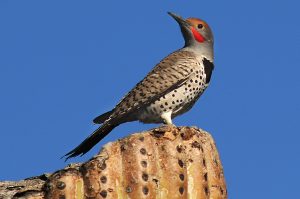
The northern flicker is yet another sizable woodpecker, measuring thirteen inches long. But unlike the others, you will often find these birds foraging on the ground.
Such northern flickers from the east or the yellow-shafted form have their underwings and tail in a bright yellow shade. The northern flicker from the west or the red-shafted form bears rosy underwings and tails.
A northern flicker's appearance, by far, is the most varied of all woodpeckers.
These birds breed throughout most of Minnesota, sometimes migrating and often a regular winter visitor in the state's southern regions.
Northern flickers burrow a new nest cavity almost yearly, performing a much-needed service for other cavity nesters, like the chickadees and ducks. You can find these birds almost everywhere, from the open woods to the woodland edges.
While a northern flicker favors ants significantly, ensuring a supply of suet, corn, and sunflower seeds will attract woodpeckers like the pileated to your backyard bird feeders.
8. Black-Backed Woodpecker
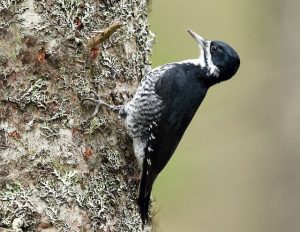
The black backed woodpecker is one of the most handsome members of the Picidae family. Its glossy black plumes harmonize perfectly with the charred trunks of burnt conifers. A black backed woodpecker also has a distinguishable stocky body and a sizable head.
Underneath, these black-backed woodpeckers have all-white feathers, black-barred flanks, black wings, and tails with white outer feathers.
You will also notice a white stripe across its black face, long gray bill, grayish legs, and three toes. Male black-backed woodpeckers sport a yellow central crown, noticeable only when they incline their heads sideway, while females have theirs in plain black.
Its unique voice sets this bird apart from the other woodpeckers in the field; the calls vary from sharp sounding, screechy rattle, and scratch calls. The drumming of a black backed woodpecker has a descending pitch as the tempo accelerates toward the end.
Its nesting site varies from utility poles to live and dead trees, whether burned or not, and rarely reuses cavities. Additionally, it is a prey expert invading burnt conifer forests for wood boring beetles, but its varying diet preferences depend significantly on food availability.
Lastly, this species prefers coniferous, subalpine, and mixed-coniferous woodlands.
9. Yellow-Bellied Sapsucker
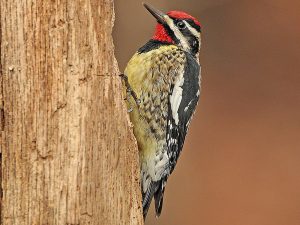
During the colder months, the yellow-bellied sapsuckers are casual visitors in Minnesota, but they breed and migrate within the state through the other seasons. Many consider this bird a nuisance for its behavior of drilling sap wells in tree trunks.
A yellow bellied sapsucker has whitish to faint yellow underparts; its belly has pale yellow feathers.
It has spotted wings, a white rump, a black tail, and light-colored outer feathers. Male yellow bellied sapsuckers sport a black-bordered red throat, while the females have white throats.
Furthermore, it is one of the few North American species that migrate, primarily feeding on tree sap, phloem, berries, seeds, beetles, and ants. Although in winter, this woodpecker prefers to drill on palm trees.
Such creatures mostly dwell in young deciduous forests and riparian zones. Aspen, birch, and maple trees are some of its favorites.
Watch This!
Frequently Asked Questions
What is the most common woodpecker in Minnesota?
The smallest and the most common species of woodpecker in Minnesota and is widespread throughout North America is the Downy Woodpecker. It's a non-migrating bird that prefers to stay within its range year-round.
Such a bird is also prevalent in many locations, although it will appreciate well-sheltered areas in suburban yards and open woodlands where deciduous trees are abundant.
Are pileated woodpeckers rare species in Minnesota?
No, Lewis's woodpecker is more of a rare species around Minnesota instead. The Lewis's woodpecker is a mid-sized bird favoring mature riparian groves but, unlike the other woodpeckers, doesn't peck on woods when foraging insects.
Regarding pileated woodpeckers, its population shows a significant increase from 1966 to 2019, as the record shows from the North American Breeding Bird Survey. Nevertheless, such a woodpecker is more common in Canadian forests, some Pacific Coast regions, and the southeastern United States.
Where do Minnesota woodpeckers stay in winter?
The northern flicker and yellow-bellied sapsucker are birds that move towards the south in winter. On the contrary, the red-headed and pileated woodpecker lingers but can be harder to find during the said season.
Many Minnesota birds migrate south for the winter, while others stay throughout the cold weather. You may continue to enjoy a spectacular view of the downy, hairy, and red-bellied woodpecker, even from your windows and backyard bird feeders.
Conclusion
If you have an insatiable fascination or curiosity about these woodpeckers in Minnesota, the state is one of the best locations to learn more about them. It has several prime birding spots where you can easily observe woodpeckers and other species.
Soon enough, given the handy tips to make birdwatching more enjoyable and productive, your curiosity will transform into appreciation. As such, it will lead to an innermost desire to preserve nature.
We have numerous opportunities to protect the ecosystem, but at the very least, we can reverse the effects of habitat loss for our feathered friends. There's no better way to do this than filling our bird feeders to the brim and creating an inviting space for these creatures.

